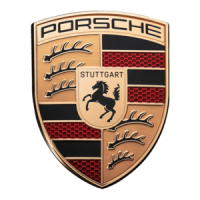44 · Drive systems and chassis | Engine technology
Air intake system.
The Cayenne models are all equipped
with a resonance air intake system.
This technology uses the pressure waves
generated by the inlet valves to ‘force’ air
into the engine.
The effect is further enhanced on the V6
engine in the Cayenne and the V8 engine
in the Cayenne S and the Cayenne GTS
by a two-stage intake manifold. This vari-
able geometry combines all the benefits
of a long intake tube (higher torque at
low rpm) with those of a shorter length
(more power at higher rpm).
The result: highly impressive torque
ratings across the entire engine speed
range.
Turbocharging system in the
Cayenne Turbo.
In the Cayenne Turbo, the engine is
assisted by twin turbocharger units
arranged in parallel – one for each bank
of cylinders. Incoming air is passed
through a filter and compressed by the
turbine units. Its temperature is then
reduced in the twin intercooler system,
which improves cylinder charging and
limits thermal loads on the engine.
Supercharging system in the
Cayenne S Hybrid.
The engine in the Cayenne S Hybrid is
equipped with a supercharger. For a
more direct response, even at low revs
and road speeds. This is particularly
useful when driving in urban traffic. The
supercharger has a low-temperature
water cooling system for cooling the
charge air.
Variable Turbine Geometry (VTG) in
the Cayenne Diesel.
The turbocharger in the Cayenne Diesel
features Variable Turbine Geometry
(VTG). The gas-flow from the engine
is channelled onto the turbines via elec-
tronically adjustable guide vanes. By
changing the vane angle, the system can
replicate the geometry in all types of
turbo, large or small, and thus achieve
the optimum gas-flow characteristics.
As a result, even at low engine rpm,
the turbine speed is maximised. For a
significant increase in boost pressure,
excellent cylinder charging plus greater
power and torque.
Electronic engine management.
Cultured performance in all driving
scenarios requires comprehensive
engine control. The electronic engine
management system does this by
continually monitoring the relevant input
data from a variety of sophisticated
sensors. This data is then compared with
a corresponding set of reference values.
Based on this information, a range of
key engine functions, e.g. ignition and
injection timings as well as injection
quantities, are seamlessly and auto-
matically adjusted. Other major functions
include on-board recuperation. It ensures
that the on-board power supply is only
replenished while the vehicle is on the
overrun. This boosts fuel economy as
well as performance, and ensures max-
imum engine output during acceleration.
All this goes unnoticed by the driver,
apart from the obvious benefits: lower
fuel consumption and CO
2
emissions plus
greater power and torque at all times.
For fuel consumption, CO
2
emissions and efficiency class data, please refer to pages 150/151.

